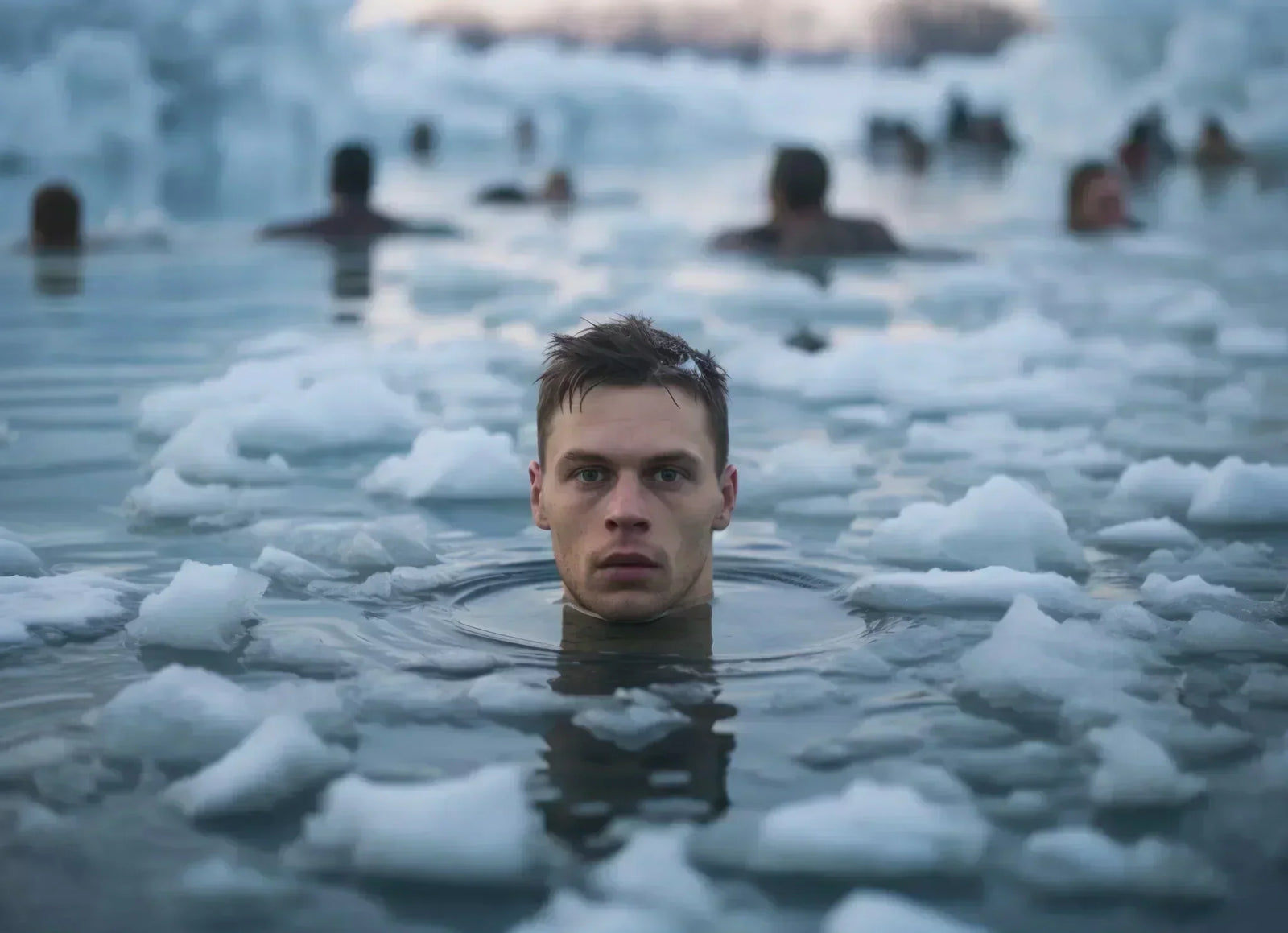Chill Out: 7 Powerful Benefits of Ice Baths for Athletes

It’s time to chill out—literally.
Ice baths have been a go-to recovery method for athletes for centuries. From Roman gladiators immersing in cold water to modern Olympians embracing the freeze, this age-old practice has stood the test of time.
But how did it go from ancient recovery ritual to a staple in NFL locker rooms and elite training centers worldwide? The 1970s marked a turning point when sports medicine began uncovering the real benefits of ice baths for athletic performance.
So, why do athletes willingly plunge into icy water after grueling workouts? Is it just a mental toughness badge, or is there real science behind it?
In today’s blog, we’ll dive into the research, uncover the seven powerful benefits of ice baths, and show you how this frosty recovery tool can elevate your training game.
Ready to take the plunge? Let’s get started!
How Do Ice Baths Help Athletes - Understanding The Science
So, what is the cold, hard truth about athletes willingness to immerse themselves into freezing water?
The truth is, this frosty recovery method has emerged as a cornerstone of sports performance. There’s real science behind ice baths and the chilly truth might just convince you to do the dip.
The Physiological Response
Stepping into an ice bath (typically 50–59°F or 10–15°C) triggers a remarkable chain of events in your body:
Vasoconstriction and Vasodilation:
- In the cold, your blood vessels constrict (vasoconstriction), redirecting blood flow from your skin to your core to protect vital organs.
- Once you step out, the opposite happens—vasodilation floods your muscles with oxygen-rich blood while flushing out metabolic waste, aiding recovery.
Nervous System Reset:
- Cold exposure activates the vagus nerve, which shifts your body from the high-alert “fight or flight” mode to the restorative “rest and digest” state. This promotes faster recovery and relaxation.
Metabolism Slowdown:
- The cold slows cellular metabolism, giving your body time to reduce inflammation and repair damaged tissue more efficiently.
By understanding these processes, it’s clear why ice baths have become an essential tool for recovery, offering athletes a physiological edge in their training and performance.
Optimal Temperature and Duration
Maximizing the benefits of an ice bath doesn’t mean plunging into frigid, Arctic-like temperatures. Instead, research highlights an ideal range for effective recovery:
-
Temperature: Aim for 50–59°F (10–15°C)—cold enough to deliver the benefits without overdoing it.
-
Duration: Your time in the bath depends on your athletic discipline:
- Endurance athletes: 10–15 minutes
- Power athletes: 5–10 minutes
- Team sport athletes: 8–12 minutes post-game
Know Your Limits:
Pay close attention to your body. Shivering excessively or feeling numbness in your hands or feet? It’s time to step out.=
Pro Tip:
Start with shorter durations at slightly warmer temperatures (around 59°F) and gradually progress to colder temperatures as your body adapts.
By following this gradual approach, you’ll build cold tolerance while avoiding the risks of cold shock or overexposure—making ice baths a safe and effective addition to your recovery routine.
Why Do Athletes Take Ice Baths? 7 Surprising Benefits

A lot of people’s first reaction to seeing or hearing about ice baths is: “what are you doing this for?”
It’s a sensible question to ask and luckily, there is plenty of proof to support the benefits.
Let's dive right into these research-backed benefits of ice baths and why they might be worth adding to your recovery routine.
#1 - Accelerated Recovery from Exercise-Induced Muscle Damage
Think of your muscles as elastic bands stretched to their limits during training. Ice baths help them snap back faster.
Research shows cold water immersion (50–59°F) reduces muscle soreness within 24–48 hours after intense exercise. Here’s what’s happening beneath the surface:
-
Cold exposure decreases inflammatory markers like interleukin-6.
-
It speeds up muscle repair processes.
Pro Tip:
Time your ice bath within 30 minutes after training for maximum recovery benefits.
Related Article: Why Muscles Get Sore After Workouts (And How to Prevent It)?
#2 - Improved Circulation and Blood Flow
Here's something cool about cold exposure - it actually improves your circulation.
When you immerse yourself in cold water, blood vessels constrict and then dilate, creating a pumping effect that enhances blood flow throughout your body.
This process:
-
Pushes more oxygen-rich blood into your muscles
-
Helps clear out metabolic waste products faster
-
Creates long-term adaptations in your circulatory system
A study shows that whole-body cryotherapy (an extreme cold simulation lasting 1-4 minutes) can enable a four-fold higher blood flow than normal.
Such a situation is observed about 4 min after the contact with cryogenic temperatures.
Moreover, this robust blood circulation change can last a few hours following exercise, resulting in the elimination of metabolic products.
You can further compound the benefits by stretching after workouts.
#3 - Reduced Inflammation and Swelling
Remember that post-workout inflammation that makes you feel like you've been hit by a truck? Maybe your Achilles hurts too much or your hamstrings feel too tight.
Ice baths can help this head-on.
The cold exposure reduces pro-inflammatory cytokines - the molecules responsible for uncomfortable swelling and pain.
In fact, a study showed that cold water immersion, when applied at 15°C for 10 minutes immediately after resistance exercise, can effectively reduce swelling and inflammation in untrained individuals.
#4 - Enhanced Mental Resilience
Ice baths aren’t just for the body—they’re a workout for your mind.
-
Cold exposure activates your stress response, training your brain to stay calm under pressure.
-
Regular practice helps regulate cortisol (your stress hormone), improving focus and resilience.
Athletes who regularly practice cold exposure may have improved concentration and mental clarity during training and competition.
#5 - Better Sleep Quality
Cold exposure influences your body's natural sleep-wake cycle in fascinating ways.
Here's what happens:
-
Your core body temperature drops
-
Melatonin production increases
-
Deep sleep phases become longer
A study observed an increase in slow-wave sleep duration after cold water immersion, which is considered the most restorative phase of sleep.
In fact, cryotherapy led to improvements in subjective sleep quality among middle and long-distance runners after muscle damage.
The key lies in timing - take your ice bath 2-3 hours before bedtime for optimal sleep benefits.
#6 - Improved Recovery Between Training Sessions
Want to bounce back faster between workouts? Ice baths can help optimize your training frequency.
Studies in the Journal of Strength and Conditioning Research reveal that cold water immersion helps:
-
Replenish muscle glycogen stores more efficiently
-
Restore strength levels faster
-
Reduce fatigue in subsequent training sessions
But here's the catch - timing matters.
Research suggests taking your ice bath within 30 minutes post-workout for optimal recovery benefits.
Stop guessing! Optimize your recovery by 5x with personalized insights.
Download GENEFIT today!Related Article: How To Recover Muscles Faster After Workout: 10 Easy Tips
#7 - Potential Performance Enhancement [h3]
Cold exposure can potentially make you a better athlete.
Recent studies in Sports Medicine show that regular ice baths can:
-
Increase endurance capacity
-
Improve power output in subsequent training sessions
-
Enhance adaptation to environmental stress
However, research indicates that exercise goals are an important consideration when deciding whether to take the plunge or not.
Cold water immersion post-resistance training has been shown to blunt muscle hypertrophy signals. This is because cold exposure might interfere with the inflammatory response needed for muscle growth.
So, if muscle growth is your primary goal, you might want to think twice about ice baths after every workout.
In the end, the key is understanding your training and performance goals. This will determine when and how often you should incorporate ice baths into your routine.
This is where genetics can help you direct your efforts (something we’ll explore in detail below)!
Pro Tip:
For strength athletes, consider using ice baths only after particularly intense sessions or during competition periods, not after every hypertrophy-focused workout.
Beyond Ice Baths - Optimizing Your Athletic Recovery With Genetic Insights
Ice baths have become a recovery staple for athletes worldwide, and for good reason. They reduce inflammation, ease muscle soreness, and boost mental resilience. But what if there's more to your recovery story?
Think of athletic recovery like a puzzle. Ice baths are just one piece – important, but not the whole picture.
Your genes play a role in how your body bounces back after intense training.
Research shows that up to 66% of recovery response variations between athletes can be attributed to genetic factors.
Some athletes might need longer recovery periods, while others can hit the ground running sooner. Knowing your genetic profile helps you make smarter recovery choices.
This is where GENEFIT steps in. The app analyzes your genetic profile to create recovery recommendations that actually work for your body.
Whether it's ice baths, compression therapy, or specific nutrition reccs – your recovery plan is based on your DNA, not someone else's.
The app also tracks your training load and recovery metrics, providing key insights into how to get the best out of your body.
Ready to recover smarter, not harder?
Download GENEFIT today!FAQs
Why do athletes sit in ice water?
Ever wonder why do athletes take ice baths right after intense training? The cold exposure (50-59°F) triggers a natural healing response in your body. It's like pressing a reset button on your muscles - they bounce back faster and stronger.
Should you take an ice bath before or after a workout?
The timing matters more than you might think. Take your ice bath within 30 minutes after training - not before.
But, what does an ice bath do for athletes post-workout?
It kicks your recovery into high gear by reducing inflammation and boosting blood circulation.
How often should athletes take ice baths?
Listen to your body on this one. For most athletes, 2-3 ice baths per week is optimal. Space them out between your hardest training sessions.
Just remember: more isn't always better.
Are cold showers good for athletes?
Cold showers offer similar benefits to ice baths but with less intensity. They're great for recovery on lighter training days or when you can't access an ice bath.
But, what does an ice bath do for athletes that cold showers can't match? Ice baths provide deeper muscle cooling and more pronounced anti-inflammatory effects.
Who should not take ice baths?
Athletes with certain conditions should avoid ice baths:
-
Heart conditions or circulation problems
-
High blood pressure
-
Recent injuries or open wounds
-
Diabetes
-
Pregnancy
Why do athletes soak in ice water despite the discomfort?
The benefits outweigh the temporary chill. But always check with your healthcare provider before starting cold therapy, especially if you have underlying health conditions.



